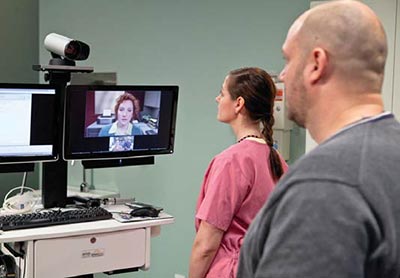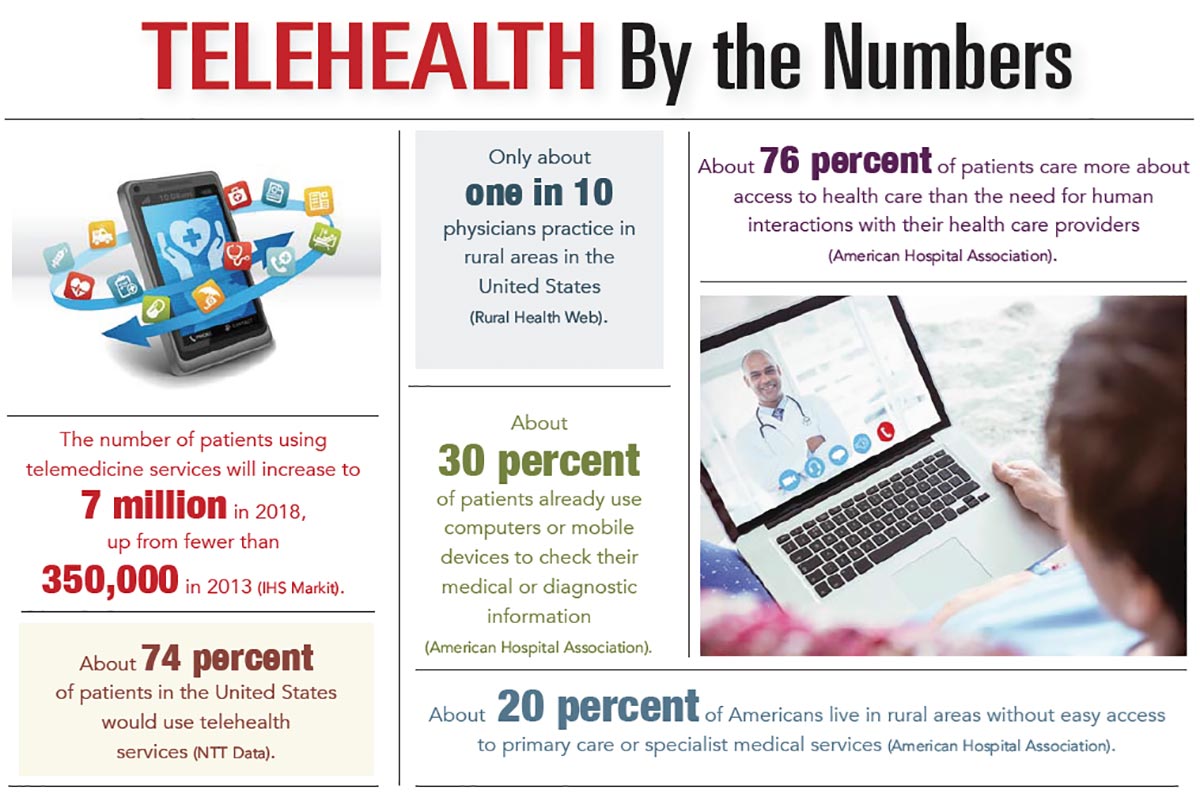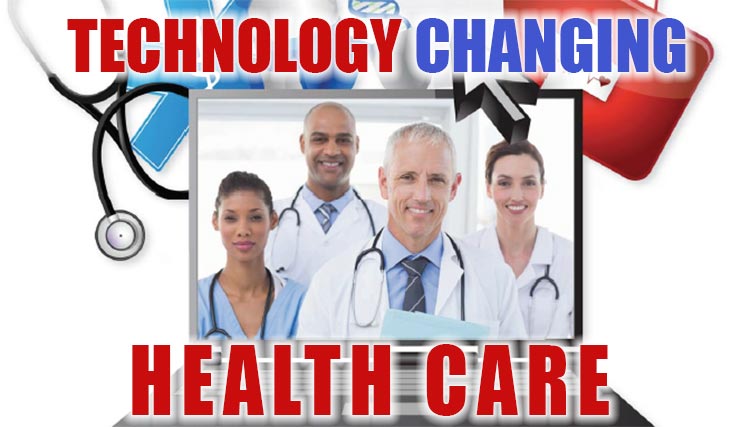Technology — it never ceases to amaze, awe and inspire. It seems that as soon as we get used to the latest and greatest, an even greater gadget comes out to replace it. In the health field, technology has taken on a role that many people feel is quite the “game changer.” Telehealth services have added a whole new realm of health care — one that offers convenience and more widespread access. It is truly changing the face of health care as we know it.
PRIMARY CARE TELEHEALTH
 Most of us have been to a Doctors Care location and, if we haven’t, we have no doubt heard of it over its 35 years in existence. Doctors Care offers urgent and primary care in 53 locations in South Carolina. The front page of its website offers the option to “see” a doctor within minutes from anywhere, using a computer, phone or tablet. Not only that, but if you would rather visit a doctor in person, you can cut your wait time in half by checking in online first. David Boucher, president and chief operating officer of UCI Medical Affiliates, the management company for Doctors Care in South Carolina, said that telemedicine, otherwise known as telehealth, was created in Doctors Care locations to improve customer satisfaction.
Most of us have been to a Doctors Care location and, if we haven’t, we have no doubt heard of it over its 35 years in existence. Doctors Care offers urgent and primary care in 53 locations in South Carolina. The front page of its website offers the option to “see” a doctor within minutes from anywhere, using a computer, phone or tablet. Not only that, but if you would rather visit a doctor in person, you can cut your wait time in half by checking in online first. David Boucher, president and chief operating officer of UCI Medical Affiliates, the management company for Doctors Care in South Carolina, said that telemedicine, otherwise known as telehealth, was created in Doctors Care locations to improve customer satisfaction.
“Consumers demand convenience and wait time is an important factor,” Boucher said. “Our patients value their time, and we respect that.”
He said patients certainly have a choice. They can see a doctor in person and risk waiting, sometimes an hour or more, or they can see a doctor within minutes online for issues such as strep throat, allergies, pinkeye, skin rashes, swimmer’s ear and even bladder infections. Patients describe their symptoms and can even have prescriptions sent to their pharmacy electronically for same-day pickup. If the telehealth physician feels a condition requires a more thorough exam, patients are referred to the closest Doctors Care clinic. The doctor can even call ahead to the clinic to let them know the patient is on the way. Seven of the Doctors Care offices in South Carolina offer in-center telehealth services so patients can be seen more quickly. Exam rooms are equipped with secure Bluetooth technology and high-definition lenses and cameras, as well as stethoscopes that allow the doctor to hear remotely.
“Our doctors say that seeing patients through this technology is always more thorough than seeing them in person because of how you can zoom in so closely and hear so vividly,” Boucher said.
Patients can make an appointment using Doctors Care Anywhere, an app approved for Apple and Android phones.
“We live in a time where fast food is not fast enough,” Boucher remarked. “It’s all about convenience. Time is valuable.”
Telehealth is offered at a flat rate of $55, and insurance is not necessary, although patients are welcome to file a claim when they use the service.
“You can be anywhere in the state and see a physician, for example,” Boucher said. “And many employer FSA or HRA programs cover this type of visit.”
“Telehealth is still in the early stages with primary care,” he added. “It will likely double in a year.”
He said there will always be a need for patients to be seen in person.
“That isn’t going away by any means, but telehealth is actually bringing access to primary care to people that didn’t have it before,” he said, pointing out that telehealth is an especially valuable tool in rural areas of the state, where there is a shortage of primary care services. “Since the state is connected by major interstates, all the rural areas have broadband and good internet connectivity.”
Jill Armbruster used Doctors Care’s telehealth services to diagnose her strep throat.
“I didn’t have to get out of bed,” she said. “It was so convenient. All I did was describe my symptoms. And the doctor could see my swollen throat, so she called in a prescription for me and I picked it up later that day.”
Armbruster said telehealth is an excellent tool for busy people with demanding schedules.
“It’s especially great for parents because they don’t have to get child care to go see a doctor,” she said. “They can see a doctor in the privacy of their own home.”
The future is bright for telehealth. Boucher sees more specialists opening up their practices to this service and more doctors coming together to collaborate through telehealth technology.
“It’s a win for patients everywhere,” he said.
MUSC TELEHEALTH
As leaders in health care, the Medical University of South Carolina has taken on a role of expanding telehealth services throughout the state and offering it in all aspects of medicine. Through the development of a statewide telehealth network known as the South Carolina Telehealth Alliance, MUSC has helped South Carolina grow to over 270 connected telehealth sites and, in 2016, reported 135,000 telehealth patient interactions. From mental health, primary care and intensive care, to neurology, dermatology, nutrition and even asthma, MUSC does it all when it comes to helping people who can’t see a doctor in person.
According to Director of Telehealth Shawn Valenta, MUSC is most proud of bringing telehealth to rural and underserved areas of the state where people previously had limited access to quality health care. An example is Williamsburg County, where MUSC now offers primary care services through telehealth in all public schools.
“Compared to the state average, children in Williamsburg were more likely to use the Emergency Department and less likely to receive child wellness visits. Telehealth has brought access to them that they didn’t have before,” he said.
MUSC also brought telehealth to the Charleston County jail last year.
“Telehealth services to the jails has the potential to save significant money because they don’t have to pay guards and drivers to get the inmates to the emergency room,” Valenta said. “They can now use this service to avoid unnecessary trips to the hospital.”
Valenta added that utilizing telehealth services has helped people receive care for simple conditions without leaving the comfort of their own home.
“It’s allowing care to be delivered in the right setting, making responses quicker for those that really need it,” he said.
MUSC is home to some of the best doctors in the world, and, through telehealth, anyone can collaborate with a specialist there.
“Consultations are a big service through telehealth, and we offer the appropriate technology to make those successful, such as examination cameras and electronic stethoscopes,” he pointed out, adding that telehealth continues to spread throughout the health care industry.
“More people are using technology because of the convenience it affords. Telehealth is transforming the way we deliver care. It has the potential to offer better cost, quality and access. We can leverage telehealth to improve the efficiency of the health care system,” Valenta concluded.
TELEHEALTH FOR VETERANS
The Veterans Administration prides itself on using the latest and greatest technologies to offer the best care to veterans. John Peters, deputy director of Telehealth Services, said the VA separates telehealth into three categories. Home telehealth is defined as health care in the home using a mobile device, messaging or video technology. Its goal is to improve patients’ clinical outcomes and access while reducing complications, hospitalizations and ER visits. Peters said one of the most common uses of home telehealth is to help veterans manage common chronic conditions such as diabetes, congestive heart failure and chronic obstructive pulmonary disease.
“About 150,000 veterans used telehealth at home in 2016,” Peters said. “Receiving VA care through home telehealth helps keep veterans healthier and happier.”
Video telehealth is defined as the use of real-time interactive video conferencing, sometimes with supportive devices such as stethoscopes, to treat a patient remotely. Most often, video telehealth takes place in a VA clinic with video conferencing to a provider at another VA location. Peters said video telehealth encompasses more than 50 different clinical applications in specialty and primary care. He added that in 2016, more than 300,000 veterans used this type of telehealth.
“Video telehealth is commonly used for mental health services but can even be used by a VA audiologist to remotely adjust a hearing aid,” he said.
Store and forward telehealth uses technology to capture information, like an image, sound or video, which is forwarded to a provider at another VA location for evaluation. This type of telehealth does not require interaction between the patient and the provider. Eye exams are an example, Peters said.
“An ophthalmologist can look at a retinal image and make determinations without requiring the veteran to travel into the VA eye clinic,” he said.
Peters noted that telehealth has helped many veterans receive care that wasn’t available to them before.
“Geographic barriers, like driving in the snow or veterans who suffer mental health conditions and cannot drive in traffic, for example, or injured veterans who cannot physically drive,” he said. “We are finding that telehealth is much more convenient for the veteran and their caregivers in many ways.”
Peters has watched telehealth services grow during his 18 years with the VA. Last year, telehealth services were used by more than 700,000 veterans.
“Back then, it was basically local video conferencing solutions, but it has grown so much,” he said. “With the rise of broadband internet and improvements in technological infrastructure, we now can offer veterans so much more through local, regional and national VA telehealth resources.”
“We are all for providing the most resources that we can to our veterans,” Peters added. “We want to make sure they have all the access and convenience they want and need in health care.”








